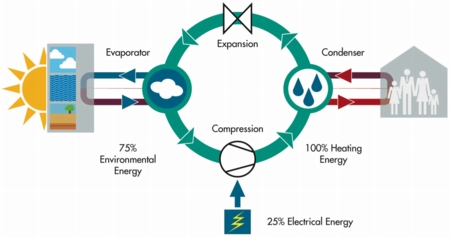Heat pumps combine low cost with low carbon on a commercial scale

Ground collectors for heat pumps can be installed horizontally, as shown here, or vertically in a borehole.
Interest in renewable energy continues to soar as fuel costs rise and legislation to reduce carbon emissions from non-domestic buildings comes into force — and heat pumps have much to offer, says Karen Trewick.The Government is using a ‘stick-and-carrot’ approach to getting control of carbon emissions across all aspects of a commercial building — combining planning policies, legislation and incentives. On the planning side, one example is the Merton rule. Named after the London borough that was the first council to incorporate renewables in its planning legislation as part of the Government’s Planning Policy Statement 22 guidance, it requires new non-residential development above 1000 m2 to generate at least 10% of their energy from on-site renewable energy equipment. One recent development set to encourage the uptake of low-carbon heating solutions is the new transparency on energy efficiency created by the extension of the requirement for Energy Performance Certificates. From April 2008 they have been a requirement upon construction, sale or lease for all non-dwellings over 10 000 m2, but since October 2008 it has been extended to all non-domestic buildings, covering everything from small high street retailers to airports. The Certificate gives an energy rating, advice on improvement and a rating from A to G, with A the best. Heat pumps are often thought of in terms of domestic installations, but there is a wide range of higher-output options suitable for a variety of commercial applications. Dimplex, for example, offers a range of ground-source heat pumps with outputs up to 130 kW and has recently introduced air source models with outputs up to 40 kW. Working alongside its installer partners, it has installed heat pumps in a variety of commercial premises including business parks, schools and community centres, a restaurant and a number of visitor centres. It is also currently fitting products into swimming pools and fitness centres. Even at sub-zero temperatures, heat pumps can draw usable heat from the ambient air, ground or underground water source and upgrade it to provide enough energy to run a heating system. Air-source and ground-source are obviously the two heat-pump technologies suitable for buildings in most locations, and are usually installed with low-temperature underfloor heating or fan convectors, although high temperature models for use with wet radiators are also available. Heat pumps are very efficient in that the only power they need is the electricity to run the compressor. For every 1 kWh of energy used to do this, the heat pump draws up to 3 to 4 kWh of free heat from the environment. This high efficiency makes heat pumps one of the more viable options for the incorporation of renewable energy. Ground-source heat pumps require the installation of ground collectors — either horizontally under a large area of land or, more commonly, vertically in a borehole (which yields more heat but requires specialist drilling equipment). The ‘brine’ that fills the ground collectors generally consists of monopropylene glycol which is non-toxic and can even be used for sensitive installations, for example those near water courses. Air-source units do not require ground collectors and therefore involve minimal disruption to the fabric of the building and its landscape, making them particularly suitable for retro-fits. Amazingly, air-source heat pumps can extract energy from the outside air even as low as -25°C. Temperatures in the UK do not fall that low, and our average winter temperature is around 5 °C, making seasonal co-efficients of performance [COPs] comparable with ground-source models.

Heat pumps take free heat from the environment and upgrade it to serve a heating system.
A major advantage of heat pumps for commercial premises is their ability to cool a space, as well as heat it. A system’s operation can be reversed to draw heat from the building and transfer it to the environment, where it is harmlessly stored for when it is needed. Heat pumps either use passive cooling, where cool water is circulated through the system without the compressor being used, reducing the ambient temperature by a few degrees, or dynamic cooling, where the compressor and heat pump cycle are reversed to extract heat from the air in the building, creating a greater cooling effect. So instead of maintaining both an air-conditioning system and a heating system, a heat pump can do both. Unlike VRF air-conditioning systems, heat pumps are hermetically sealed and only need minimal and straightforward maintenance. High-capacity reversible units with outputs of up to 75 kW, are suitable for both heating and cooling in commercial buildings. In cooling mode, the range uses recovered heat to produce either domestic hot water or heating for swimming pools. Now really is the time to investigate heat pumps. Not only is choice in high-capacity equipment opening up, but the pressure on building managers to ‘green up’ their premises will increase. And with heating and cooling available from the one system, heat pumps offer a route to hassle-free, low-cost, low-carbon heating.
Karen Trewick is with Dimplex.

High-output heat-pumps such as this Dimplex SI 50 130TE are ideal for commercial installation.
Related links:
Related articles:











